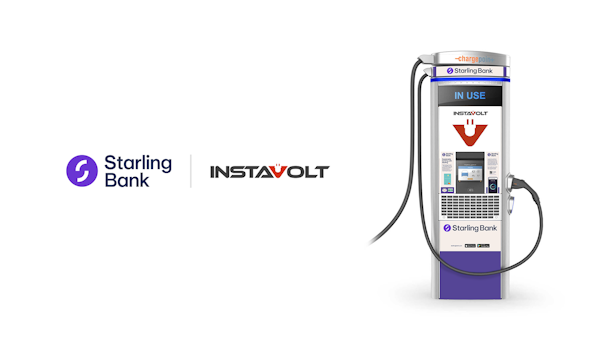For Starling Bank, electric car charging stations are a tactical media buy
Starling Bank will be the first brand to do an advertising takeover of InstaVolt’s electric vehicle (EV) charging stations across the UK. The Drum takes a look at the strategy.

Starling Bank will wrap each charger in its branding, as well as run ads on the digital screens and app
Starling Bank is just 18 months into a marketing push that has seen it run its first TV ad campaign. Not content with following a tried-and-tested media plan, it’s opted to embark on a takeover of 100 of InstaVolt’s EV charging stations in a three-month-long experiment.
It’s the first time InstaVolt has allowed a brand to advertise on its sites. Chief executive Adrian Keen tells The Drum that it’s been approached numerous times over the past year from brands looking to capitalize on the largely young, affluent and environmentally-minded audience that is using its stations every day.
“We were getting approached by lots of brands looking to put a logo on our charger. And we’re thinking, then you can’t pretend to play in this [sustainability] space, you’ve got to be serious about it. We realized there was an opportunity to reach audiences in a different way, but the [advertiser] had to be sincere and believable. We want partners who, frankly, want to challenge the old way of doing things,” Keen says.
The numbers suggest it could be a promising channel for the right brand.
The UK has nearly 24,000 public charging points – one of the largest networks in Europe – and the government has committed to a £1.3bn investment for electric vehicle infrastructure.
Auto companies are also making massive investments. Just last week Stellantis, the global car company, which owns Vauxhall, said it will invest more than €30bn (£26bn) in electric vehicles between now and the end of 2021 as it tries to make the total cost of owning an electric vehicle equal to that of a petrol-driven model by 2026.
InstaVolt is putting itself at the heart of this shift. It has over 650 chargers at 270 sites across England, Scotland and Wales, though it plans to have 5,000 within the next five years.
In rural locations, there might be just a couple of charging sessions per day, but at larger sites, such as those in retail parks, over 80 cars per day will plug in to a single charger. And the average time spent at a site is 35 minutes.
The charger is much bigger than the average at-home version, which might be the size of a shoe box. An InstaVolt station stands at roughly six feet tall.
A digital screen sits on each charger and users have to interact with it to start and stop a session; a recently launched app also allows drivers to control the session from their phones.
Starling Bank will take over 100 chargers for three months, wrapping each charger in its branding as well as running ads on the digital screens and app.
Keen to build its sustainability credentials – Starling was the first UK bank to start issuing Mastercard debit cards made from recycled plastic – every time someone pays with their Starling card the company will plant a tree through Trillion Trees.
“We’ve gone for a fairly simple approach for this,” says Rachel Kerrone, head of brand at Starling. “We’re very much seeing this as a brand awareness campaign [...] so we’ve gone for clean branding that we may change as we go through. This is something we’ve never done before.”
It’s opted for a range of sites, from inner-city to those on popular routes to British holiday destinations such as the Lake District, booming this summer thanks to Covid-induced travel restrictions.
“We’ll track our brand awareness and we can obviously tell [if it’s working] by customers that are making payments,” she adds. “We’ll keep looking at whether we’ve chosen the right sites.”
Keen declines to discuss the financials around Starling Bank’s campaign, but says it’s able to tailor the advertising packages and provide bespoke solutions depending on the type of channel chosen, whether it be screens, charger branding or in-app branding.
“We’re all going to learn a little bit from this. This is the first of its kind. I think it’s a really exciting project to see how drivers engage more with these opportunities,” he adds.
“We will learn through this together. We were pretty visionary when we brought charging to the UK in the manner that we did. And this is another big first step.”

